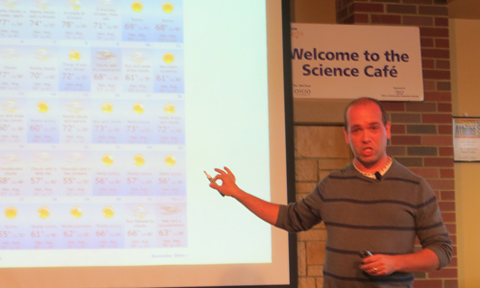Dr. Ryan Fogt, said “All Coupled Climate Models Are Wrong, Some are Useful” in his Fall 2014 Science Café talk.
Fogt is Associate Professor of Geography at Ohio University. His research focuses on the Antarctic and the Southern Hemisphere climate.
“I use climate models in my research on understanding the human footprint on climate change going on in Antarctica and to understand interactions between other parts of the planet and Antarctica,” he said.
Fogt said he had two goals for his talk.
“The first goal is to convince you and build a case that weather forecasting is a lot different than climate modeling. And if you don’t like weather forecasts, and don’t trust weather forecasts, that should have no bearing whatsoever in your belief about climate change and what climate models are telling us.
“The second goal is the bigger goal…. I strive to teach you tonight in some way that climate models are really the only tool that we can use to understand the human footprint on climate change, and they’re the only tool that allows us to possibly see into the future and what possible scenarios there might be for our future climate. They are absolutely crucial for understanding the science of climate change and the why of climate change—what’s causing the climate to change.”
Fogt explained that weather forecasts use models based on chaos theory, and therefore they are usually wrong. “That might scare you. You might say, ‘OK these models are wrong for predicting weather here, how can we ever predict climate?’ That’s because climate is very different from weather.” Climate is the average weather over a period of at least 30 years, he said.
Fogt showed “coupled climate models,” which are state-of-the-art models being used today for policy decisions. Four types of models—atmosphere, ocean processes, land cover, and the cryosphere—all work together simultaneously into one coupled climate model.
“But here’s the sad news. It’s wrong. But not in the way that you might think,” he said. The coupled models are wrong as “forecasting” models, he said. They don’t tell us what will happen on any given day. “No. These coupled climate models do not work that way….But (they are) still incredibly useful.”
He compared the coupled models to looking at the forest, not an individual tree. “Even though they are not producing the exact Earth as we see it, they have a very powerful use.” They allow researchers to simulate how the model responds to various anthropogenic effects.




















Comments